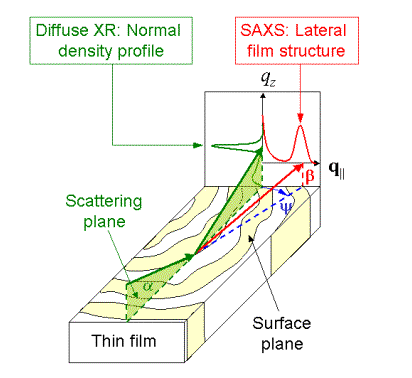
Detlef-M. Smilgies
[home]

In order to make x-ray scattering surface sensitive, a grazing
incidence
angle
a
is chosen between about half the critical angle ac
and several critical angles. The actual choice depends on the system to
be studied. For free-standing quantum dots, an
incident angle below ac may be
chosen to make the scattering exclusively surface-sensitive [Metzger]. In order
to
probe the internal structure of a polymer thin film of 100 nm
thickness, the
incident
angle should be above ac of the
film,
to ensure a full penetration of the sample [Smilgies].
The area detector records the scattering intensity of scattered rays over a range of exit angles b and scattering angles y in the surface plane. A beam stop has to be set-up to block spill-over direct beam as well as the reflected beam and the intense diffuse scattering in the scattering plane.
In the scattering plane the GISAXS intensity distribution
corresponds
to a detector scan in Diffuse Reflectivity. The intensity distribution
parallel to the surface plane corresponds to SAXS. The full GISAXS
intensity
map can be theoretically described within the framework of
Distorted-Wave
Born-Approximation [Rauscher, Lazzari].
Structure factor - lateral and normal density correlations
GISAXS provides information both about lateral and normal ordering at a surface or inside a thin film. This shall be illustrated with the example of lamellar films formed by symmetric polystyrene-polybutadiene block copolymers. In a block copolymer two inmiscible polymer chains are coupled by a chemical bond. If both chains occupy equal volumes, a lamellar phase is formed. In a thin film, i.e. if the thickness of the film is on the order of the lamellar period, the presence of two interfaces, air-film and film substrate, may induce preferential order in the film as compared to the bulk polymer which forms a 3D powder of micron-sized lamellar domains:
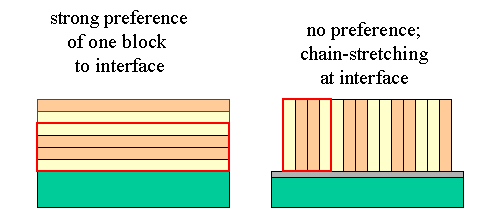
If interfacial energies are the dominant factor, i.e. if one of the
block strongly favors the interface, parallel lamellae are formed. If
the interfacial energies of the blocks are similar, interfacial entropy
will determine the orientation of the blocks. In particular, chain
stretching in the vicinity of the bond between the chains yields a
perpendicular orientation of the lamellae, while the chain end effect
favors a parallel orientation [Pickett]. As the
entropic effects scale with the chain lengths, even a morphology change
as a function of chain length is possible. This has been indeed
observed for PS-PB, where parallel lamellae are observed for short
chains and perpendicular lamellae for long chains [Papadakis]
What kind of scattering will result from these two extreme cases ?
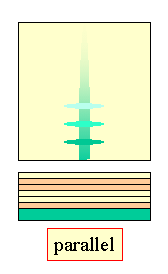 |
If one of the blocks strongly favors one of the two
interfaces, or
even both, the lamellae will be parallel to the substrate. The classic
example is PS-PMMA on a Si wafer covered with the native oxide [Anastasiadis].
The signature of parallel lamellae in GISAXS are stripes of intensity
at
regular spacings along the qz direction. In
Langmuir-Blodgett
films, such stripes in the diffuse reflectivity are referred to as
Bragg
sheets. The schematic shows the diffuse scattering only (the intense
specular reflection from the surface is omitted).
Strictly speaking, the sketched pattern is obtained within the validity of the Born-Approximation, i.e. if the scattering angles are well above the critical angle. For scattering angles close to the critical angle, scattering patterns may be more complicated, which can be explained within the framework of DBWA theory [Busch3] |
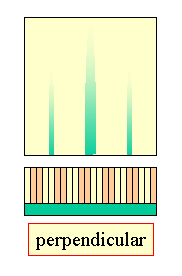 |
If both blocks have similar interface energies, chain stretching at the interface comes into play. Chain stretching occurs at the link between the inmiscible blocks of the polymer. A nematic ordering of this stretched part parallel to the interface may become favorable giving rise to the formation of perpendicular lamellae. As both interactions scale differently with the degree of polymerization [Pickett], there can be a transition from parallel lamellae to vertical lamellae, as we have found for PS-PB [Busch]. The signature of perpendicular lamellae are correlation peaks parallel to the interface, with a streaklike shape normal to the surface, similar to the scattering rods in Grazing-Incidence Diffraction [Als-Nielsen]. |
Note that perpendicular lamellae still have the freedom to change
direction
parallel to the surface plane - in fact AFM pictures [Busch,
Busch2]
show that meandering lamellae are formed. Such a system constitutes a
2D
powder, similar to monolayers at the air-water interface [Als-Nielsen].
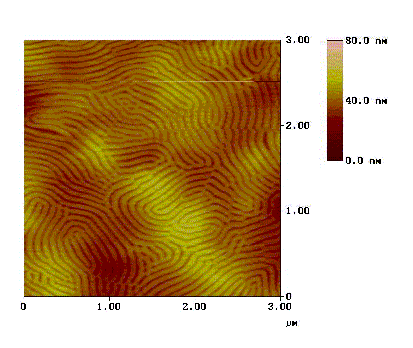
AFM image of a diblock copolymer film |
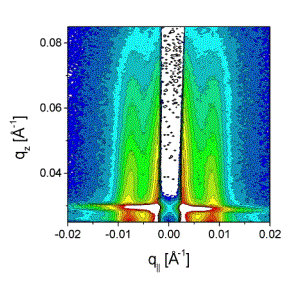
GISAXS from the polymer film |
The scattering from such a lamellar system with a period of about
800
Å is so strong, that in-situ time-resolved measurements of the
swelling
of the film in solvent vapor on a timescale of minutes were possible [Smilgies].
Often, though, the ordering is not quite so perfect:
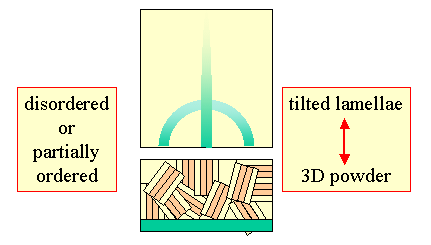 |
In thick films the ordering induced at the interfaces may not
prevail throughout the film, and the interior of the film may assume
the 3D powder bulk structure. Rings or partial rings in the intensity maps can indicate anything from complete disorder of the lamellar domains to partial ordering, e.g. lamellae with a finite distribution of tilt angles with repect to the interface. |
Not always does the kinetics of the film formation allow a
complete
ordering of the films. This is particularly important in a system like
PS-PB [Busch, Papadakis],
where the morphology
changes from
parallel
lamellae to prependicular ones as a function of chain length. At these
intermediate chain lengths there is only a small preference of one
morphology
over the other, and the system is hence slow to reach equilibrium. In
this case a mixture of different structures is observed.
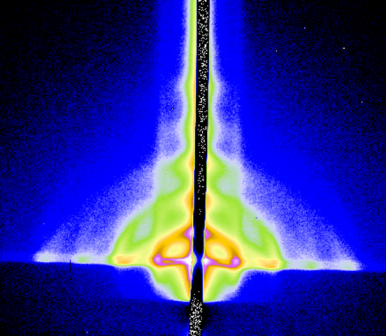
PS-PB sample with a chain length in the
intermediate regime.
A mixture of parallel, perpendicular, and unoriented lamellae
is observed.
Thin films with other block copolymer morphologies than the lamellar
phase have been
analyzed recently [Du, Xu, Li]. In
their study of silica
surfactant
mesophases the kinetics of the formation of various morphologies has
been
studied by Gibaud et al. [Gibaud].
Preferential lateral ordering and patterning
All examples discussed so far were 2D powders, i.e. had rotational averaging with respect to the surface normal, resulting in a rotationally homogeneous scattering intensity. However, by patterning the substrate, further ordering may be imposed on the film, and structures may show a preferential orientation with respect to the substrate as seen in polymer blends where the surface had been prepared by alternating hydrophobic and hydrophilic stripes [Böltau].
Similarly, regular patterns can be prepared by lithographic
techniques
[Woll]
representing an artificial lamellar system PMMA-air. In these cases the
GISAXS intensity distribution depends now also on the azimuth angle f of the substrate.
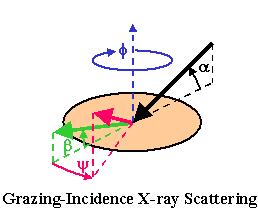
Basic scattering angles for a GISAXS experiment. If the structure is
anisotropic in the film plane,
the GISAXS intensity map will depend on the sample azimuth f.
Form factor
Another type of scattering is observed for nano-objects with a
narrow
size distribution and well-defined shape. Here the form factor
dominates
the scattering, in particular, if the nano-objects are randomly placed
on the surface. Examples are monodisperse nanoparticles absorbed on a
wafer
surface [Du] and quantum dot arrays [Metzger].
Below the calculated scattering intensity from a dilute layer of
elliptical
nanoparticles on a wafer surface is shown in kinematical approximation
(left panel).
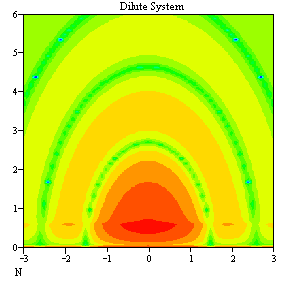
elliptical nanoparticles: dilute layer |
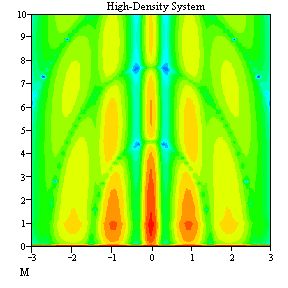
elliptical nanoparticles: dense layer |
The characteristic form factor oscillations are clearly to be seen in the parallel and the perpendicular direction. When the exit angle of the scattered beam is close to the critical angle, signal enhancement due to the Vinyard effect [Vinyard] occurs, resulting in a bright band of intensity at the critical angle. This is also refered to as the Yoneda peak. Below the critical angle the scattering intensity falls quadratically off to zero.
For a dense layer of nanoparticles, particles have more or less well-defined nearest-neighbor distances. This density correlation gives rise to a structure factor with characteristic modulations parallel to the surface, but constant in the perpendicular direction (right panel). The characteristic intensity streaks are related to the scattering rods in Grazing-Incidence Diffraction [Als-Nielsen], and are modulated by the form factor.
In our simulation, all the structure was produced by the product of
just three functions, the form factor F(qy,qz),
the structure factor
S(qy),
and the Vinyard factor T(qz), where the qy and qz
components of the
scattering
vector q are parallel and perpendicular to the substrate
surface, respectively.
This quasi-kinematic approach has been first introduced by Naudon for
studying
the formation of nanoparticles on surfaces and in buried layers [Naudon].
An exact approach has been given by [Rauscher]
within the framework of
distorted-wave
Born approximation which was further elaborated by [Lazzari].
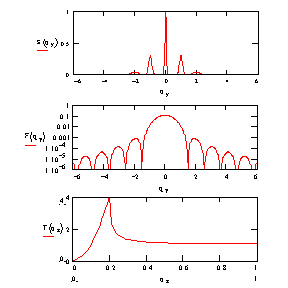 |
S(qy) form factor Vinyard factor |
Oriented nanoparticles
The highest degree of information on nanoparticles is obtained, if
these
have not only uniform shape, but also uniform orientation. The classic
example are pyramid-shaped quantum dots on single crystalline surfaces
[Metzger]. In the latter case the scattering
intensity
of a line scan taken parallel to the surface depends on the relative
orientation
of the pyramids to the beam as given by the azimuth angle f
of the sample. Another spectacular example of very highly oriented
monodisperse
nanoparticles are the growth studies by Renaud et al. in an all-vacuum,
windowless small-angle scattering set-up [Renaud].
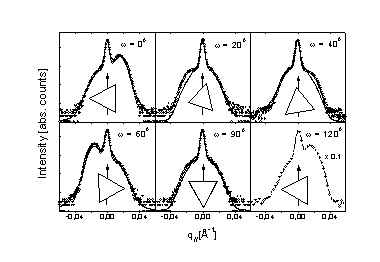
Orientation-dependence of the scattering from quantum dots
shaped like three-sided pyramids [Metzger].
Summary
Mesoscopic systems can display a large range of ordering properties. Each of these has a well-defined signature in its GISAXS intensity pattern. Moreover, due to the penetration power of x-rays, not only surface structures, but also the internal structure of thin films and buried interfaces can be studied without any need of elaborate sample preparation, as needed for instance for cross-section transmission electron microscopy. Hard x-rays can penetrate air, vapor, and small amounts of liquid allowing samples to be studied in-situ and in real time [Smilgies]. All of these features make GISAXS a very versatile tool to study shape and/or density correlations in nanoscopic systems.
(based on a talk given at the Physical Electronics Conference on Cornell Campus, June 2003)
(version 2/15/2005)
References
| [Als-Nielsen] | J. Als-Nielsen and D. McMorrow: "Elements of modern X-ray physics", (John Wiley & Sons, New York, 2001). |
| [Anastasiadis] | S. H. Anastasiadis, T. P. Russell, S. K. Satija, and C. F. Majkrzak: "Neutron reflectivity studies of the surface-induced ordering of diblock copolymer films", Phys. Rev. Lett. 62, 1852-1855 (1989) |
| [Böltau] | M. Böltau, S. Walheim, J. Mlynek, G. Krausch, U. Steiner, Nature 391, 877 (1998). |
| [Busch] | P. Busch, D.-M. Smilgies, D. Posselt, F. Kremer, and C.M. Papadakis: "Grazing-incidence small-angle x-ray scattering (GISAXS) - Inner structure und kinetics of thin block copolymer films", Macromol. Chem. Phys. 204, F18-F19 (2003). (preprint) |
| [Busch2] |
P. Busch, D. Posselt, D.-M. Smilgies, F. Kremer and C. M. Papadakis: ''Diblock copolymer thin films investigated by tapping mode AFM: Molar mass dependence of surface ordering'', Macromolecules 36, 8717-8727 (2003). |
| [Busch3] | P. Busch, M. Rauscher, D.-M. Smilgies, D. Posselt, and C. M.
Papadakis:
"Grazing-incidence small-angle x-ray scattering (GISAXS) as a tool for
the investigation of thin nanostructured block copolymer films - The
scattering cross-section in the distorted wave
Born approximation", in preparation. |
| [Du] | Phong Du, Mingqi Li, Katsuji Douki, Xuefa Li, Carlos B.W.
Garcia, Anurag
Jain, Detlef- M. Smilgies, Lewis J. Fetters, Sol M. Gruner, Ulrich
Wiesner,
Christopher K. Ober: "Additive-driven Phase Selective Chemistry in
Block
Copolymer Thin Films: The Convergence of Top Down and Bottoms Up
Processing", Advanced Materials 16, 953-957 (2004). (cover) |
| [Gibaud] | A. Gibaud et al.: "Evaporation-Controlled Self-Assembly of
Silica Surfactant
Mesophases", J. Phys. Chem. B 107, 6114-6118 (2003). |
| [Lazzari] | R. Lazzari, J. Appl. Cryst. 35, 406-421 (2002). |
| Levine | J. Levine, J.B. Cohen, Y.W. Chung, P. Georgopoulos, "Grazing-Incidence Small-Angle X-ray Scattering: New Tool for Studying Thin Film Growth", J. Appl. Cryst. 22, 528 (1989). |
| Levine2 | J.R. Levine Parrill, P. Georgopoulos, Y.-W. Chung and J.B. Cohen: "GISAXS - Glancing incidence small angle X-ray scattering", J. Phys. IV France 3-C8, 411-417(1993). |
| [Li] |
Mingqi Li, Kasuji Douki, Ken Goto, Xuefa Li, Christopher Coenjarts, Detlef M. Smilgies, and Christopher K. Ober: "Spatially Controlled Fabrication of Nanoporous Block Copolymers", Chem. Mater. 16, 3800-3808 (2004). |
| [Metzger] | T. H. Metzger, I. Kegel, R. Paniago, A. Lorke, J. Peisl, J. Schulze, I. Eisele, P. Schittenhelm, and G. Abstreiter: "Shape, size, strain and correlations in quantum dot systems studied by grazing incidence X-ray scattering methods", Thin Solid Films 336,1-8 (1998). |
| [Naudon] | A. Naudon in H. Brumberger (ed.) "Modern Aspects of Small-Angle Scattering", (Kluwer Academic Publishers, Amsterdam, 1995), p. 191 |
| [Papadakis] |
C. M. Papadakis, P. Busch, D. Posselt, and D.-M. Smilgies: "Morphological Transition in Thin Lamellar Diblock Copolymer Films as Revealed by Combined GISAXS and AFM Studies ", Advances in Solid State Physics, Vol. 44 (Springer Verlag, Heidelberg, 2004) p. 327-338. |
| [Pickett] | G. Pickett, T. Witten, S. Nagel, Macromolecules 26, 3194 (1993). |
| [Rauscher] | M. Rauscher, T. Salditt, and H. Spohn: "Small-angle X-ray scattering under grazing incidence: the cross section in the distorded-wave Born approximation", Phys. Rev. B, 52(23), 16855-16863, (1995). |
| [Renaud] | G. Renaud et al.: "Real-Time Monitoring of Growing Nanoparticles", Science 300, 1416 (2003). |
| [Smilgies] | Detlef-M. Smilgies, Peter Busch, Dorthe Posselt, and Christine M. Papadakis: "Characterization of Polymer Thin Films with Small-Angle X-ray Scattering under Grazing Incidence (GISAXS)", Synchrotron Radiation News, Issue 15(5), p. 35-42, 2002. (preprint) |
| [Vineyard] | G. H. Vineyard: "Grazing-incidence diffraction and the distorted-wave approximation for the study of surfaces", Phys. Rev. B 26, 4146-4159 (1982). |
| [Woll] | unpublished. (follow the link to see a pretty picture) |
| [Xu] |
T. Xu, J. T. Goldbach, M. J.
Misner, S. Kim, A. Gibaud, O. Gang, B. Ocko, K. W. Guarini, C. T. Black, C. J. Hawker, and T. P. Russell: "Scattering Study on the Selective Solvent Swelling Induced Surface Reconstruction", Macromolecules 37, 2972-2977 (2004). |